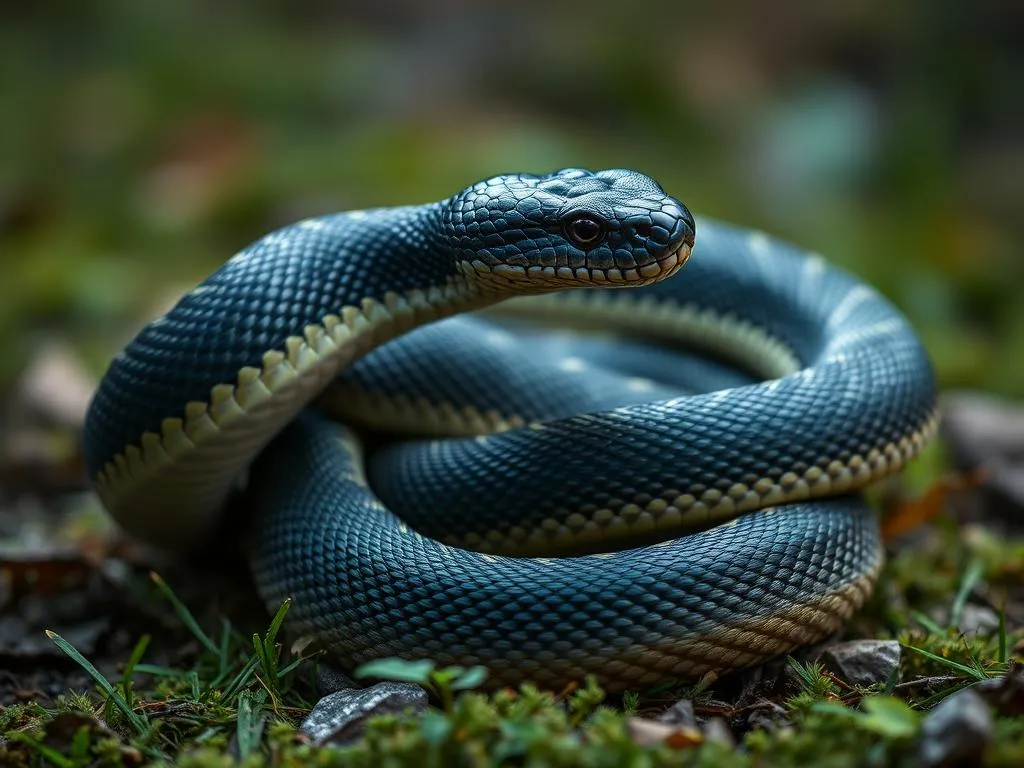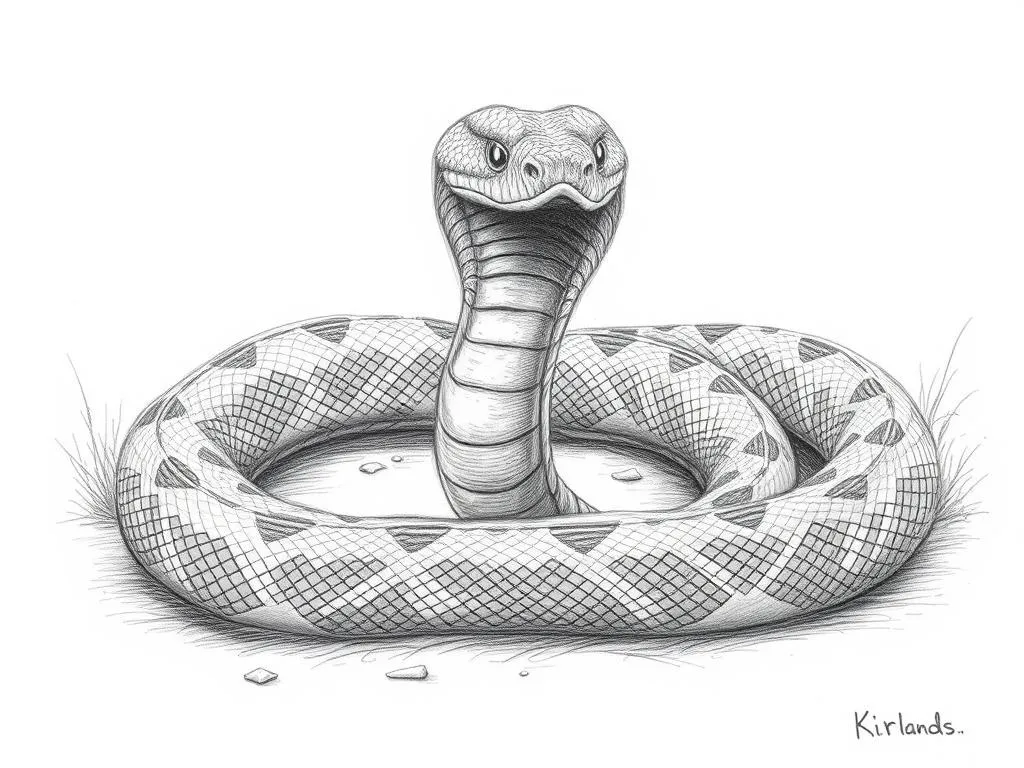The Enigmatic Kirtland’s Snake: Symbolism and Spiritual Insights

Disclaimer: Some images on this website are AI-generated artworks and may not accurately represent real animals.
The Kirtland’s snake, a fascinating creature native to the midwestern United States, holds profound symbolism and meaning. This blog post will explore the various aspects of the Kirtland’s snake, shedding light on its physical characteristics, habitat, conservation status, and its rich symbolism in both spiritual and cultural contexts.
Understanding Kirtland’s Snake
Physical Characteristics
The Kirtland’s snake is a small, non-venomous snake that boasts a unique appearance. Below is a summary of its physical traits:
| Feature | Description |
|---|---|
| Length | Typically 18 to 30 inches |
| Color | A striking blend of gray, brown, and black |
| Patterns | Distinctive dark blotches and a light belly |
| Eyes | Small and dark, giving it a subtle appearance |
| Tail | Short and slender, often with a slight taper |
The Kirtland’s snake is notable for its smooth scales and slender body shape, which allow it to navigate through its preferred moist habitats, typically found near wetlands, marshes, and prairies. Its coloration provides excellent camouflage among the leaf litter and grasses of its environment, making it a master of stealth.
Habitat and Range
The Kirtland’s snake is predominantly found in specific regions of the Midwest, particularly in Michigan, Ohio, and parts of Indiana. It favors areas with abundant moisture, such as wetlands and floodplains, where it can hunt for its primary food sources: earthworms and small invertebrates.
These habitats are crucial not only for the survival of the Kirtland’s snake but also for the ecological balance of the regions they inhabit. By controlling the population of soil-dwelling organisms, the Kirtland’s snake plays a vital role in maintaining the health of its ecosystem.
Conservation Status
Unfortunately, the Kirtland’s snake faces numerous threats, primarily due to habitat loss from urban development, agriculture, and climate change. As a result, it has been classified as a species of concern in several states. Conservation efforts are in place to protect its remaining habitats and promote awareness about the importance of biodiversity.
Organizations and local governments are actively working to restore wetland areas, implement protective legislation, and increase public education regarding the significance of the Kirtland’s snake and its habitat.

Symbolism & Spiritual Meaning
Transformation and Renewal
In many cultures, snakes are potent symbols of transformation and renewal, and the Kirtland’s snake is no exception. The shedding of its skin is a powerful metaphor for personal growth and the ability to let go of the past. This act signifies a fresh start, encouraging individuals to embrace change and move forward in their lives.
When one encounters the Kirtland’s snake, whether in nature or through dreams, it may serve as a reminder that change is not only necessary but also a vital part of the human experience. Just as the Kirtland’s snake sheds its skin, we too can shed old habits, beliefs, and thoughts that no longer serve us.
Adaptability
The adaptability of the Kirtland’s snake highlights the significance of resilience in facing life’s challenges. This snake thrives in diverse habitats, showcasing its ability to adjust to changing environments.
In our own lives, adaptability is crucial. Embracing the lessons of the Kirtland’s snake can inspire us to remain flexible in the face of adversity, reminding us that we have the strength to navigate life’s twists and turns with grace.
Wisdom and Intuition
The Kirtland’s snake also embodies wisdom and heightened intuition. Its ability to sense changes in its environment allows it to thrive despite potential threats. This connection to intuition encourages us to trust our instincts and listen to our inner voice.
When we embrace the wisdom of the Kirtland’s snake, we are reminded to pause, reflect, and seek deeper understanding in our lives. This snake serves as a guide, encouraging us to develop a stronger relationship with our own intuition.
Kirtland’s Snake in Dreams
Interpreting Snake Dreams
Snakes often appear in dreams, and their symbolism can vary widely based on context. The Kirtland’s snake, specifically, can carry unique meanings. Below is a table summarizing some common themes associated with snake appearances in dreams:
| Dream Theme | Possible Interpretation |
|---|---|
| Encountering a Snake | Facing change or transformation in waking life |
| Chasing or Being Chased | Avoiding personal growth or confronting fears |
| Snake Shedding its Skin | Letting go of the past; embracing new beginnings |
| Hiding or Coiling | Feeling vulnerable; needing protection |
| Positive Interaction | Connection with intuition; gaining wisdom |
Personal Reflection
If you find yourself dreaming about the Kirtland’s snake, take time to reflect on the emotions and situations surrounding the dream. What changes are currently happening in your life? Are there areas where you feel stagnant or resistant to growth?
Dreams involving the Kirtland’s snake encourage introspection and invite you to explore your own journey of transformation. Consider journaling your thoughts and feelings to gain clarity and insight into your personal experiences.
Modern Interpretations
Cultural Significance
In various cultures, snakes have been revered and feared, often representing duality. The Kirtland’s snake, with its unique characteristics, serves as a symbol of the delicate balance between nature and humanity.
In Native American beliefs, snakes often symbolize healing and transformation, while in other cultures, they can represent deceit or danger. The Kirtland’s snake’s role in these narratives emphasizes the importance of understanding and respecting our connection to nature.
Symbolism in Art and Literature
The Kirtland’s snake has found its way into modern media, including literature and art. Writers and artists often use snake symbolism to convey deeper meanings related to transformation and the natural world.
For example, in contemporary literature, the snake can symbolize hidden truths and the journey of self-discovery. The Kirtland’s snake, with its unique habitat and ecological role, serves as a powerful reminder of the interconnectedness of all living beings.
Environmental Awareness
The plight of the Kirtland’s snake has become a focal point in advocating for environmental protection and biodiversity. As public awareness grows about the threats facing this species, more individuals are inspired to engage in conservation efforts.
By understanding the significance of the Kirtland’s snake, people are motivated to protect its habitat and promote sustainable practices that benefit not only this species but also the environment as a whole.
Key Takeaways
- The Kirtland’s snake symbolizes transformation and personal growth, encouraging individuals to embrace change.
- Adaptability is a key lesson from the Kirtland’s snake, reminding us to remain flexible in the face of challenges.
- The wisdom and intuition associated with the Kirtland’s snake invite us to trust our instincts and seek deeper understanding.
- Dreams involving the Kirtland’s snake can provide valuable insights into personal experiences and emotional states.
- Understanding the cultural significance of the Kirtland’s snake helps foster a greater appreciation for biodiversity and environmental protection.
Conclusion
The Kirtland’s snake is much more than just a creature of the marshes and wetlands; it embodies rich symbolism that resonates with themes of transformation, adaptability, and wisdom. By delving into the meanings associated with this enigmatic snake, we can gain valuable insights into our own lives and the world around us.
In recognizing the importance of the Kirtland’s snake, we are reminded of our responsibility to respect and protect the natural world. By engaging with nature and considering the deeper meanings of the creatures that inhabit our surroundings, we can foster a greater understanding of ourselves and the interconnected web of life.







